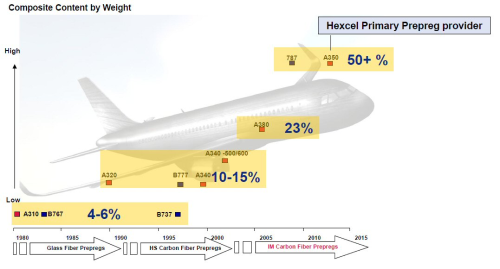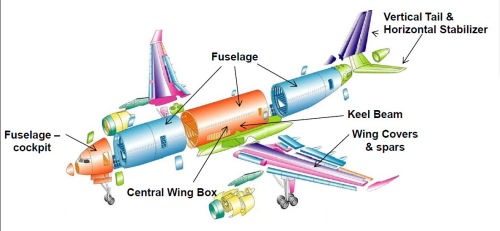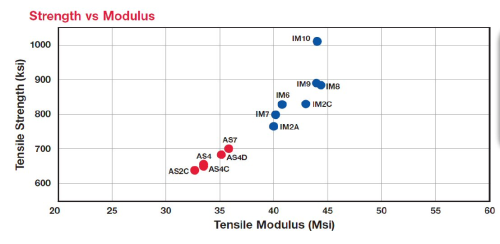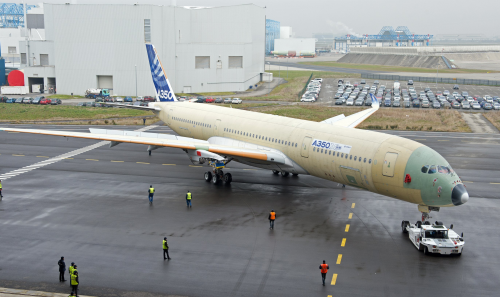



Hexcel discussed its significant involvement in the A350 XWB programme during a press conference at the JEC Europe 2013 trade show (12-14 March.)
Increased composites use
Hexcel's Commercial Aerospace business accounted for 60% of its 2012 sales of US$1.58 billion. Revenues from this sector have increased at a CAGR of 11% over the period 2004-2012, led by increasing build rates and new, composites-intensive aircraft programmes.
Boeing and Airbus, which account for the majority of Hexcel's commercial aerospace revenues, have both been progressively increasing their adoption of composites over the years (see Figure 1).
Hexcel's contract for Airbus' new A350 XWB wide-body twinjet is the biggest in its history and is expected to generate revenues of US$4-5 billion over the lifetime of the contract.
Hexcel's HexPly® M21E epoxy prepreg made with HexTow® IMA intermediate carbon fibre is used to manufacture the A350 XWB's fuselage panels, keel beam, the entire wing (covers, spars and centre wing box) and empennage (see Figure 2). Hexcel's total material content on each A350 XWB aircraft is expected to be over $4 million.
For Hexcel, the first flight of the A350 XWB will be the culmination of eight years of product development and qualification and investment in new and expanded manufacturing facilities.
Materials development
Hexcel secured the contract to supply carbon fibre materials for the A350 XWB's primary structures in 2008, by developing a complete composite proposal, including prepreg and associated products. This involved development of both fibre and resin technology within the company.
The fibre is one of the most important constituents in any prepreg, explains Paul Mackenzie, Hexcel VP R&T, and being able to provide enhanced intermediate modulus carbon fibre technology to meet the requirements of the A350 programme was an important aspect of Hexcel's development. The result is HexTow IMA, which provides superior mechanical performance including very high tensile strength (850-900 Ksi) and tensile modulus (40-42 Msi).
Hexcel has a long history of supplying structural prepregs to the aerospace industry. Its HexPly M21 and 8552 systems are widely used at Airbus and are employed on the A380 and A400M programmes. Hexcel chemists developed HexPly M21E epoxy resin to provide enhanced toughness and durability, to ensure the propertiest of the fibre are fully optimised in the cured prepreg laminates.
The prepreg is supplied as unidirectional (UD) tape, which can be very finely slit for automated fibre placement (AFP) and automated tape laying (ATL) processes.
Serving a global supply chain
A further challenge of the programme for Hexcel was ensuring the timely supply of materials to the A350’s global supply chain. In addition to Airbus, around 30 Tier 1 manufacturers, including Aerolia, ATK, GKN, Premium Aerotec and Spirit, are producing structures for the A350 using HexPly M21E/IMA prepreg around the world.
"A key reason for our success, beyond the technology, beyond the mechanical performance of our products, is having the right supply chain to provide timely, huge volumes of prepregs to Airbus and its supply chain throughout the globe," affirms Thierry Merlot, Hexcel VP & General Manager Europe/MEA/Asia Pacific.
To produce the vast quantities of prepreg required for the A350 XWB programme Hexcel introduced a new model for the cost-effective large-scale production of prepreg. This involved producing resin film in a continuous process to very tight aerial weight tolerances in Duxford, UK. This has improved the quality, accuracy and consistency of the resin film, giving customers greater control of the cured ply thickness in the parts they produce.
| Hexcel's contract for Airbus' new A350 XWB wide-body twinjet is the biggest in its history and is expected to generate revenues of US$4-5 billion over the lifetime of the contract. |
The resin film from the UK is delivered to Hexcel facilities in France, Spain and Germany, where the company has invested in new prepreg equipment to produce high qualilty UD prepreg, that is split if requried (for ATL and AFP processing). It is then supplied to nearby Airbus facilities and its Tier 1 suppliers throughout Europe and the USA.
Hexcel reports that this supply chain model for prepreg production results in shorter lead times, greater responsiveness, reduced transportation of materials, point of use delivery, less packaging, reduced inventory and less requirement for cold storage space.
Hexcel has significantly expanded it carbon fibre and prepreg production capacity in order to support the A350 programme.
To meet the increased demand for HexTow carbon fibre, new lines have been added at Hexcel’s PAN precursor facility in Decatur, Alabama, USA; new carbon fibre lines have been commissioned in Salt Lake City, Utah, USA; and the company built its first European carbon fibre manufacturing plant in Illescas, Spain.
On the prepreg side, in addition to new matrix plants in the UK and prepreg plant expansions in Spain, Germany and France, Hexcel is currently commissioning a new plant at its Salt Lake City, Utah, facility.
New technologies
Mackenzie also talked about two new Hexcel technologies for future aircraft programmes. In addition to prepreg technologies, the company is also developing out of autoclave technologies, and trying to anticipate future demands of aerospace manufacturers.
HiTape®, which was launched at JEC, is an example of this. This is a UD tape reinforcement designed for out of autoclave processing of primary aircraft structures which is said to offer mechanical properties equivalent to prepregs. (See Hexcel HiTape offers out of autoclave processing of primary aircraft structures.)
"It is a UD tape-type product which you are able to get a very high volume fraction, a 58-60% volume fraction you would expect from prepreg technology, but more importantly, you are able to deposit this in a very high deposition rate approaching 50 kilos an hour, “ Mackenzie explains. “After it’s been laid down to provide the preform, it is then infused with a resin system in order to then cure off out of autoclave to make the final part.”
This development will provide cost improvement in terms of being able to process out of an autoclave-type environment, together with a high mechanical performance.
Mackenzie also highlights HexMC, a carbon fibre/epoxy moulding compound designed for compression moulding for specific point design parts. (See HexMC carbon fibre moulding compound for high volume aircraft parts.)
|
In addition to the primary structure, Hexcel is supplying a number of other HexPly prepregs for other structures on the A350 XWB. HexPly 8552 woven and UD prepregs, HexPly M65 woven BMI prepreg and HexPly 914/ASC woven prepreg are used in the engines and nacelles along with Hexcel's engineered core and Acousti-Cap® broadband noise reducing honeycomb. The belly fairing is made from HexPly M26T and F593 woven carbon prepregs, and HexPly M59XF expanded copper foil prepreg. HexWeb® Engineered Core packages are used extensively in the wing leading and trailing edges and ailerons. Other Hexcel products used on the aircraft include HexFlow® RTM 6 infusion resin and HexForce® engineered reinforcements for out of autoclave structures, Redux® adhesives and lightning strike protection solutions. |
"It is a chopped fibre product, but it is based on a prepreg system, and as a result has mechanical performance that is certainly excellent, and provides the sort of mechanical performance that can actually then go on to replace titanium fixtures which it is targeting to replace,” MacKenzie reports. “So from HexMC, you’re looking at a number of different types of applications for clips, for brackets, for pans to static guide lanes, and this has also been established, and has been used both on 787, and is also being now considered for use on A350.”
"So this is another technology that Hexcel is developing in order to provide further design options for our aerospace customers to move away from metal and metal technology,” he concludes.
First flight
The A350 XWB is scheduled to take its first flight this summer. Launch customer Qatar Airways is expected to receive its first A350 in mid-2014 and introduce it into passenger service soon afterwards.
Airbus has sold 617 aircraft so far. The smallest of the three models, the A350-800 (270 passengers), has a list price of US$254.3 million. ♦
See also:
- ATK to supply composite structures and tooling for Airbus A350 XWB;
- GKN transfers composites expertise to A350 wing;
- Spirit AeroSystems delivers first A350 XWB centre fuselage section to Airbus;
- Airbus A350 XWB update.
This article will be published in the May/June issue of Reinforced Plastics magazine.
The digital edition of Reinforced Plastics magazine is distributed free of charge to readers who meet our qualifying criteria. You can apply to receive your free copy by completing the registration form.



